


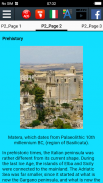
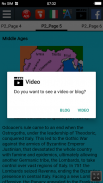
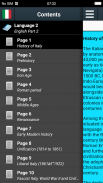
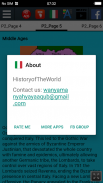
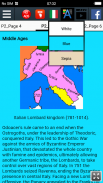
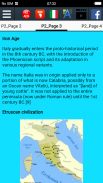
History of Italy

توضیحات History of Italy
The Italian peninsula shows evidence of habitation by anatomically modern humans beginning about 43,000 years ago. It is reached by the Neolithic as early as 6000 BC (Cardium Pottery in Coppa Nevigata). The Italian Bronze Age begins around 1500 BC, likely corresponding to the arrival of Indo-European speakers whose descendants would become the Italic peoples of the Iron Age; alongside the early Italic cultures, however, the Etruscan civilization in central Italy and Greek colonies in the south flourished during 8th to 5th centuries BC.
Among the Italic peoples, the Latins, originally situated in the Latium region, and their Latin language would come to dominate the peninsula with the Roman conquest of Italy in the 3rd century BC. The Roman Republic and later the Roman Empire dominated Italy for many centuries, and furthermore established the culture and civilization of Western Europe in general, including the adoption and subsequent spread of Christianity as state religion at the end of the 4th century.
The decline and collapse of the Western Empire by the end of the 5th century is taken to mark the end of Late Antiquity. A Lombard Kingdom of Italy was established, although parts of the peninsula remained under Byzantine rule and influence until the 11th century. The Lombard kingdom was incorporated into Francia and ultimately the Holy Roman Empire, although the rise of city-states, and especially the powerful maritime republics in the medieval period led to political fragmentation. Ultimately, after the disastrous Italian Wars, the peninsula was divided among the major foreign powers of Early Modern Europe, Spain and Austria, and later fell to the French Empire under Napoleon I, the Papal States being reduced to the control of the Holy See over Rome.
شبه جزیره ایتالیا شواهدی از حضور انسان آناتومی بدن انسان مدرن شده توسط آغاز در مورد 43،000 سال پیش نشان می دهد. این است که توسط نوسنگی رسیده به عنوان اوایل 6000 پیش از میلاد (سفال Cardium در کوپا Nevigata). ایتالیایی عصر برنز آغاز می شود در حدود 1500 سال قبل از میلاد، به احتمال زیاد مربوط به ورود هند و اروپایی سخنرانان که بازماندگان آن به مردم کج عصر آهن تبدیل شده است؛ در کنار فرهنگ کج اولیه، با این حال، اتروسک در مرکز ایتالیا و مستعمرات یونانی در جنوب در طول 8 به قرن 5 قبل از میلاد رونق گرفت.
در میان مردم کج، لاتینها، در اصل در منطقه لاتیوم واقع شده، و زبان لاتین خود خواهد آمد به تسلط شبه جزیره با فتح روم ایتالیا در قرن 3rd قبل از میلاد. جمهوری روم و بعد از امپراتوری روم ایتالیا برای قرن تحت سلطه، و علاوه بر فرهنگ و تمدن غرب اروپا به طور کلی در تاسیس، از جمله تصویب و گسترش پس از آن از مسیحیت به عنوان دین رسمی کشور در پایان قرن 4th.
کاهش و سقوط امپراتوری غربی در پایان قرن 5 گرفته شده است به مناسبت پایان اواخر باستان. لومپارد پادشاهی ایتالیا تاسیس شد، هر چند که بخش هایی از شبه جزیره تحت حاکمیت امپراتوری بیزانس و نفوذ تا قرن 11th باقی مانده است. پادشاهی لومپارد به Francia از و در نهایت امپراتوری مقدس روم گنجانیده شده بود، اگر چه ظهور شهرستان کشورهای، و به خصوص جمهوری قدرتمند دریایی در دوره قرون وسطی منجر به پارگی سیاسی. در نهایت، پس از جنگ به نمایش گذاشت ایتالیایی، شبه جزیره میان قدرت های بزرگ خارجی از مدرن اولیه اروپا، اسپانیا و اتریش تقسیم شد، و بعد از سقوط به امپراتوری فرانسه تحت ناپلئون اول، ایالات پاپی که به کنترل از مقدس بیش از کاهش رم.

























